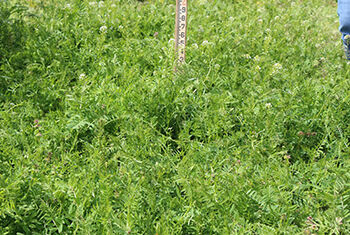Cover crops offer producers many soil health benefits, such as suppressing weeds, increasing organic matter, improving soil structure, reducing soil loss, increasing nutrient and water holding capacity just to name a few. These benefits cannot be fully achieved unless the cover crops are planted at the proper rate and date for optimum growth and productivity.
NRCS Plant Materials Centers in the central region have recently completed studies comparing seed dates and planting rates of cover crops.
Evaluation of cool season cover crop planting dates in northeastern Missouri
PMC recently completed a three-year study investigating the effect of different fall planting dates of cover crops in northeastern Missouri. Learning the most effective time for planting cover crops is important in determining how species and varieties fit within cropping systems. Multiple cover crop species were planted in August, September, October, and November and monitored through the spring for growth and productivity. Species tested included three grasses (annual ryegrass, cereal rye, winter oat), three legumes (crimson clover, hairy vetch, winter pea), three brassicas (broadleaf mustard, canola, oilseed radish) and three forbs (buckwheat, flax, phacelia).
Most species had greater winter hardiness, canopy cover and biomass production when planted in August, September, or October, but exhibited little to no growth when planted in November. In general, legumes performed best when planted in the late summer (mid-August), while in contrast, grasses performed best when planted later in the fall (mid-October). Cool season grasses and legumes over-wintered better than most of the brassicas and forb species. Results from this study suggests planting cool season cover crop species prior to November to produce greater canopy cover and biomass in the spring. Planting early-maturity varieties of cash crops can accommodate planting cover crops in the early to mid-fall season.
Seeding rates’ effect on biomass production of cool season legume cover crops in the Texas rolling red plains
James E. “Bud” Smith Plant Materials Center in Knox City, Texas, evaluated five common cool season cover crop legumes at differing seeding rates over two years. Species including ‘Wyo’ winter pea (Pisum sativum), ‘AU Merit’ hairy vetch (Vicia villosa), VNS common vetch (Vicia sativa), ‘Dixie’ crimson clover (Trifolium incarnatum), and ‘Frosty’ berseem clover (Trifolium alexandrinum) were planted at the recommended rate, then at 25%, 50%, and 150% of the recommended seeding rate. Crimson clover and berseem clover produced the highest biomass when seeded at the recommended seeding rate compared to the 25% and 150% of the recommended seeding rate but the increase in biomass was minimal.
Similar results were seen in the common vetch, hairy vetch and winterpea with 150% of the recommended seeding rate producing slightly more biomass than the recommended seeding rate or 25% of the recommended seeding rate. These results suggest that reducing the seeding rate of these cover crop species may be possible in the Texas Rolling Red Plains. However, additional testing is needed to verify these findings along with canopy cover measurements to assess soil protection by the different seeding rates. In addition to more testing at the PMC there also needs to be on-farm field testing to validate seeding rate recommendations.
Results from this 2-year seeding rate study are not conclusive enough to adjust seeding rates of cover crops recommended by NRCS for producers participating in USDA programs. Data from this evaluation, when combined with the results of many more studies including from other partners of the Southern Cover Crop Council will be important to potentially make future adjustments to cover crop seeding rates and reduce the costs of cover crop plantings.
For additional information on specific cover crop species mentioned above, please see the USDA PLANTS database. Technical information and guidance regarding cover crops and soil health is available on the Plant Materials Program website or contact the nearest Plant Materials Center or plant materials specialist.



